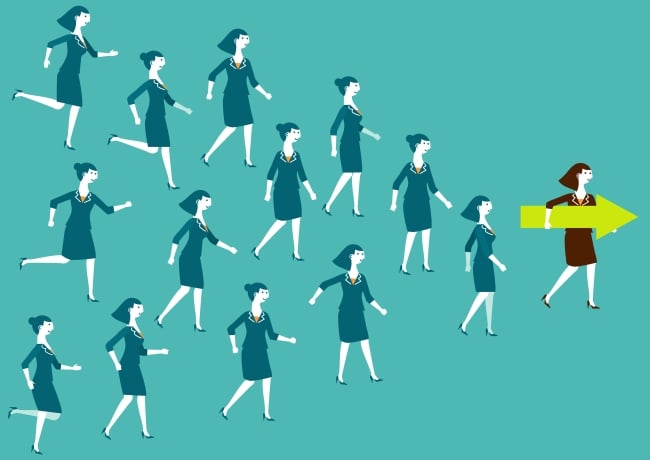You have /5 articles left.
Sign up for a free account or log in.

iStock/runeer
During the HERS Institutes, we focus much of our time on the skills that women in academe need to lead change projects. On a recent visit to the University of Alaska Anchorage, HERS alumnae there asked me to talk about the much broader topic of leading in changing times. When we're talking about leading in changing times, we're talking about leading while the ground continues to move. You have to be able to make new changes even as you're making the changes you planned.
In such circumstances, our campuses require more than a small cadre of strong, smart leaders. Leading in changing times calls for response-enabled leadership. By that I mean they need numerous people across the institution who are in a position to know what's going on and are encouraged to share information about what they're sensing and engage with each other in responding. Our campuses need not only individual leaders but also a collective environment of leadership.
I proposed three connected strategies for creating an environment of response-enabled leaders.
Develop a shared understanding of the broad context in which changes are occurring. When the ground is moving, it is hard not to focus on what's right in front of you that needs to be changed. But it's important for you and others on your campus to step back to see the bigger picture and develop among yourselves a broader sense of the context. What multiple things are coming together to change your understandings and expectations? What is no longer matching your students’ needs?
Most of us start with the assumption that our lives in higher education are being changed primarily because of the serious budget constraints under which we have been working since the global economic crisis of 2008. I’d suggest that most of the major issues we’re trying to address with fewer resources were at least in the works well before that. Whether it's changing student demographics, new uses of instructional and communications technology, the unfinished agenda of diversity and inclusion, or shifts in funding models -- they all had already been emerging for a couple of decades before.
The financial crash has certainly increased the urgency of those challenges. The unevenness of the economic recovery has created local microclimates in which specific conditions across sectors of higher education and regions of the country vary. Has your campus created opportunities for faculty and staff members to discuss your local conditions? Do people have a shared understanding of your institution’s greatest challenges and options for responding? What would allow you to achieve a greater connection with your goals and your local conditions?
What you can do in these collective conversations is draw back from specific situations to see how the broad landscape has changed. And you can ask yourself, given the broader context, what is most likely to work best in your new environment?
Change what you are doing rather than simply adding something. Without a shared sense of what might have an impact across many areas of the campus, everyone will be trying to address just what is in their corner. As a result, you will very likely end up adding activities rather that restructuring, because really new approaches require a larger scope beyond a single department or unit. If instead you see the broader landscape, then you can try to determine how to respond to the new needs by changing how you deal with them -- rather than simply adding to fill the gap.
I find universal design a useful metaphor here. How can you create a process that does something a little differently -- and serves a lot more people? Or perhaps develop a tool that is more flexible and handles some different situations without adding a whole new set of things in the drawer?
I have a recent example from a HERS Institute alumna. Joan is a librarian who used to hate adding more and more remedial library skills sessions during new student orientation. She felt that she was doing someone else’s work and trying to cram it in before classes started so faculty members could count on students having the skills for their courses. The problem was that students didn’t enjoy the sessions any more than she did, and often faculty members had to send students back for more help during the term. She stopped adding sessions during the already crowded orientation period. Instead she enlisted faculty members in the classes most likely to use the library during the opening semester to build a calendar of library skills sessions within their class schedules. The students now get the information from library staff when they are most likely to use it and thus retain it.
Enable people to take responsibility while acknowledging change often brings losses. Were the original remediation orientation sessions “failures”? Joan saw it differently: the sessions were no longer the best matches for the starting points of the current students. The only failure would have been to continue them after it was clear something better should be tried. The staff and faculty members involved undoubtedly felt some level of disorientation and loss at giving up the roles they had played and the satisfaction they had felt in assisting students in need. Some had enjoyed being part of the bustle of orientation. Some wanted acknowledgment that they cared about the students’ success when others on the campus had not. Were they now going to be seen as the ones forced to change?
Ronald Heifetz, founder of the Center for Public Leadership at Harvard’s Kennedy School, points out that we usually do not resist change; we really resist the losses that come from change. A significant loss for anyone in the academy is our sense of mastery. (We knew how to do that but not this.) Another painful loss is our standing as experts and professionals. (We don’t need anyone to tell us how to do things -- we tell them.)
The worst loss for most people in any situation is the loss of community. Interestingly, we often create community by taking sides. In these changing times, the sides can form quickly between people who resist change and those who are annoyed with the resisters. How can we take responsibility to lead changes if we feel we’re losing our team?
We can shift roles more easily if we refrain from the blaming and shaming that too often erupts in changing times. When things are uncertain, it is tempting to blame others for not having taken action earlier. (They should have listened when some of these ideas were proposed before.) And if you face second-guessing and discrediting when making changes, you are likely to hold your old position in self-defense. But if you can keep framing things in terms of responding to a changing landscape, you can let people have a clean slate for acting right now. How you respond to this challenge is what matters.
Share a sense of the broadly changed landscape, reimagine your options for a more universal design in your responses and appreciate those who focus on both the present and the future. Those are the actions of a response-enabled community.




